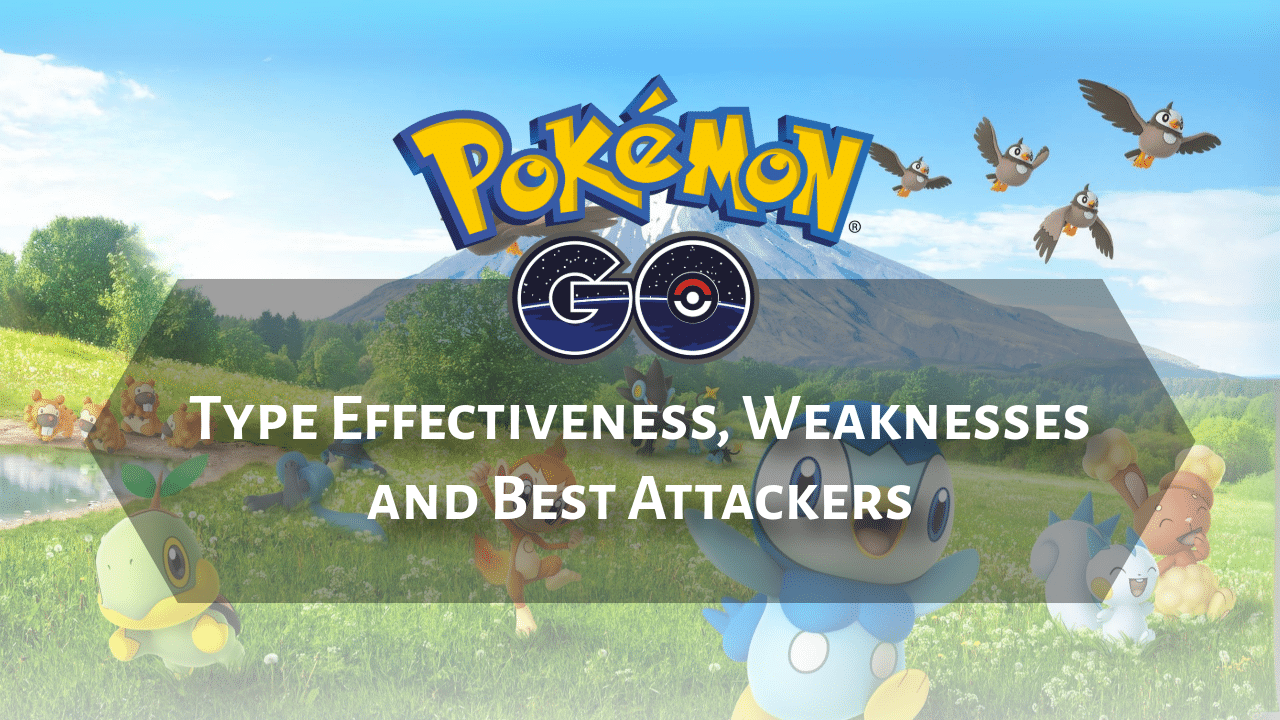Pokemon Go Type Effectiveness, Weaknesses, And Best Attackers - Theria Games

In Pokémon GO, mastering type effectiveness is crucial for gaining an advantage in battles. Each of the 18 Pokémon types interacts differently, with some dealing extra damage to certain types while being weak against others. Super-effective attacks deal 1.6× damage, while not-very-effective attacks deal only 0.625× damage. If a Pokémon has two types, weaknesses and resistances stack, leading to double weaknesses (2.56× damage) or double resistances (0.39× damage). Certain types, like Dragon, Ice, and Fighting, are commonly used in high-level battles due to their offensive strength, while others, like Steel and Fairy, offer strong defensive capabilities.
Gyms and raids require exploiting type advantages for maximum damage, especially in timed battles against raid bosses. In the GO Battle League, type matchups determine a Pokémon’s viability, as even a strong Pokémon can struggle against an opponent with the right counter. Understanding these mechanics allows trainers to build balanced teams, switch strategically, and maximize damage output, leading to consistent victories.
The Foundation of Battle: Understanding Type Effectiveness
Because type matchups influence both offensive and defensive strategies, trainers must carefully consider their team compositions to maximize their chances of success in battles. A well-balanced team should include Pokémon that cover a variety of type strengths while minimizing shared weaknesses. This is especially crucial in formats like the GO Battle League, where a single unfavorable matchup can cost an entire battle. Having a diverse team with strong counters ensures that a trainer is prepared for different opponents rather than relying too heavily on a single Pokémon.
A common mistake among newer trainers is choosing Pokémon based purely on Combat Power rather than their typing and move effectiveness. While CP is important, understanding type interactions and move advantages is what truly separates an average trainer from an expert. Utilizing resources like the Pokemon GO Type Effectiveness, Weaknesses, and Best Attackers guide can help trainers make informed decisions when selecting Pokémon for battles, ensuring they have the right counters and most effective move sets for any situation.
Another critical concept to master is the same type attack bonus, commonly known as STAB. When a Pokémon uses a move that matches one of its own types, the attack receives a 1.2 times damage boost, making it significantly stronger than it would otherwise be. For example, a Water-type Pokémon using a Water-type move will deal more damage than a Pokémon of a different type using the same move. This bonus is especially useful when combined with super-effective attacks, allowing trainers to deal massive damage in battles. Choosing Pokémon that can take advantage of both STAB and type effectiveness provides an edge in combat, especially in high-stakes battles such as raids or ranked PvP matches.
In Gym battles and raids, leveraging type effectiveness is key to defeating opponents quickly and efficiently. Raid bosses in particular have high HP, and exploiting their weaknesses allows trainers to maximize damage within the time limit. The faster a raid boss is defeated, the greater the chance of earning extra Premier Balls to catch it. This is why it is crucial to enter raids with well-prepared Pokémon that have the right type advantages.
Using Pokémon with fast-charging and high-damage charge moves of a super-effective type ensures that battles are completed faster and with fewer resources spent on healing and reviving fainted Pokémon. Additionally, trainers who coordinate with others and bring Pokémon of the same advantageous type can further amplify damage output and make raid battles easier.
In PvP battles, type matchups dictate both lead Pokémon selection and strategic switching. A Pokémon that starts with a type disadvantage can be quickly countered, forcing the trainer to either switch or sacrifice that Pokémon. Skilled trainers anticipate their opponent’s switches and adjust accordingly, maintaining favorable matchups while conserving shields and energy. Since different leagues, such as Great League, Ultra League, and Master League, feature varying meta Pokémon, staying informed about common threats and their weaknesses is essential. The best trainers not only know which types counter others but also understand energy management, shield usage, and move timing to outplay opponents even in neutral matchups.
Beyond individual battles, type knowledge plays a role in events and special challenges within Pokémon GO. Many events introduce unique raid bosses, limited-time PvP formats, or research tasks that require battling specific types of Pokémon. Trainers who already understand type advantages can quickly adapt to these events, making the most of rare opportunities to catch powerful or exclusive Pokémon. Furthermore, when participating in Team GO Rocket battles, knowing how to counter Shadow Pokémon efficiently ensures smoother victories while preserving valuable healing items.
By mastering type effectiveness, STAB, resistances, and strategic switching, trainers can significantly improve their battle performance across all aspects of Pokémon GO. Whether battling in gyms, raiding powerful bosses, or competing in the GO Battle League, making informed type-based decisions will consistently lead to better results and more victories. The most successful trainers are those who take the time to learn and apply these principles, ensuring that every battle is approached with strategy rather than relying on brute force alone. Understanding type effectiveness is not just about knowing which attacks deal more damage—it is about making smarter choices that turn the tide of battle in your favor.
Navigating the Pokemon GO Type Chart: A Guide to Offensive and Defensive Strategies
The Pokémon GO type chart serves as an essential tool for trainers looking to master battle strategies by understanding type interactions. This chart visually represents the relationships between the 18 different Pokémon types, helping trainers quickly identify which attacks are super effective, not very effective, or neutral against a given opponent. The type chart is typically structured in a grid format, with the attacking type listed along one axis and the defending type along the other. By finding the intersection of these two types, trainers can determine the exact effectiveness of an attack, allowing for more informed battle decisions.
For an effective offensive strategy, selecting Pokémon and moves that are super effective against the opponent’s type ensures maximum damage output. This approach is especially critical in raids, where time efficiency determines the number of Premier Balls earned, as well as in PvP battles, where fast and effective damage can force opponents into unfavorable switches. Understanding the weaknesses of enemy Pokémon allows trainers to make proactive choices, whether by selecting the right Pokémon before a battle begins or by quickly switching in a more advantageous Pokémon mid-battle. Trainers who take the time to study these matchups will find themselves consistently outmaneuvering opponents and securing more victories.
Defensively, knowing type weaknesses and resistances is equally important. Recognizing which attacks your Pokémon are vulnerable to helps in anticipating your opponent’s strategy and adjusting accordingly. A well-balanced team should minimize common weaknesses while maximizing resistances to ensure durability across multiple battle formats. Certain Pokémon with strong resistances, such as Steel-type Pokémon that resist multiple attack types, can serve as valuable defensive options. In addition, dual-type Pokémon have complex interactions with type effectiveness, sometimes allowing them to take neutral damage from attacks that would otherwise be super effective.
One crucial factor to remember is that the effectiveness of an attack is determined by the attack’s type, not the type of the Pokémon using it. However, Pokémon often learn moves that match their own type, which activates the same type attack bonus, commonly referred to as STAB.
When a Pokémon uses a move of its own type, the attack receives a 1.2x damage boost, making it significantly stronger than the same move used by a Pokémon of a different type. While STAB is not as impactful as type effectiveness multipliers, it is still a vital component of battle strategy, particularly when combined with super-effective moves. Dual-type Pokémon have the advantage of benefiting from STAB for moves of both of their types, giving them more offensive flexibility.
Mastering type interactions through the Pokémon GO type chart, exploiting type weaknesses, and leveraging STAB are key elements in becoming a top-tier trainer. Whether battling in raids, gym challenges, or PvP, understanding these mechanics ensures that every move is made with precision, increasing the likelihood of victory. By studying the type chart and applying this knowledge in battles, trainers can develop a strategic edge that sets them apart from the competition.
Unraveling the Web: Key Type Matchups and Their Logic
While memorizing the entire type chart can seem like a daunting task, understanding some fundamental relationships can significantly aid your comprehension. Many type matchups have a logical basis grounded in real-world concepts, making them easier to remember. Fire-type attacks are super effective against Grass-type Pokémon because fire burns plants. In turn, Grass-type attacks are super effective against Water-type Pokémon since plants absorb water for growth. Water-type attacks are strong against Fire-type Pokémon because water extinguishes flames. These three types form a natural triangle that is easy to recall and frequently referenced in Pokémon battles.
Beyond these elemental basics, other type matchups follow similar reasoning. Electric-type attacks are super effective against Flying-type Pokémon, reflecting the real-world danger of lightning striking birds in the sky. Rock-type moves also deal extra damage to Flying types, aligning with the phrase “kill two birds with one stone.” Psychic-type attacks are particularly strong against Fighting-type Pokémon, emphasizing the concept that intelligence and mental strength can overcome brute force. However, Psychic-types struggle against Dark and Ghost-types, representing the human mind’s fear of the unknown and supernatural. Another example is Ground-type Pokémon resisting Electric-type attacks, which makes sense because electrical currents are nullified when grounded.
Some interactions are less intuitive but can be learned through practice and repeated exposure in battles. For example, Bug-type moves being super effective against Dark-type Pokémon can be linked to the idea that small creatures like insects can disrupt and unsettle even the most fearsome predators. Dragon-type Pokémon taking extra damage from Ice-type attacks relates to mythical dragons being vulnerable to freezing temperatures. Steel-type Pokémon resisting Poison-type attacks reflects the real-world principle that metals do not get poisoned or corrode easily. These logical associations make it easier to predict effective strategies even if you do not have the full type chart memorized.
By focusing on these intuitive connections and regularly referencing a type chart during battles, trainers can gradually develop a strong understanding of Pokémon GO’s type effectiveness system. With time and experience, recognizing advantageous matchups will become second nature, allowing for better decision-making in raids, Gym battles, and PvP competitions.
Navigating Dual Typings: Increased Complexity and Strategic Depth
The presence of dual-type Pokémon adds a significant layer of complexity and strategic depth to battles. A dual-type Pokémon inherits both the advantages and disadvantages of its two types, creating unique interactions that can heavily influence battle outcomes. These Pokémon may experience extreme vulnerabilities or gain valuable resistances depending on their type combinations.
One of the most important aspects of dual typing is the concept of double weaknesses. When both of a Pokémon’s types are weak to the same attack type, the damage multiplier increases significantly. For example, Rayquaza, a Dragon- and Flying-type Pokémon, takes 2.56 times the normal damage from Ice-type attacks because Ice is super effective against both Dragon and Flying. This makes Ice-type Pokémon and Ice-type moves extremely powerful counters against Rayquaza in raids and PvP battles. Similarly, Tyranitar, a Rock- and Dark-type Pokémon, takes massive damage from Fighting-type moves since both Rock and Dark share a weakness to Fighting. Recognizing these double weaknesses can give trainers a huge advantage when selecting their battle teams.
On the other hand, dual typing can also neutralize weaknesses by balancing out vulnerabilities. If one of a Pokémon’s types is weak to a certain attack type but its other type resists that same attack, the weaknesses and resistances cancel each other out, resulting in neutral damage. For instance, Shuckle, a Bug- and Rock-type Pokémon, takes normal damage from Fire-type attacks. While Bug is weak to Fire, Rock resists Fire, preventing any increased or reduced damage. This balancing effect is important to consider when planning defensive strategies, as certain Pokémon can withstand attacks that would otherwise be super effective against single-type Pokémon.
Additionally, dual-type Pokémon can benefit from multiple same type attack bonuses, or STAB, allowing them to deal extra damage with two different types of moves. For example, Charizard, being a Fire- and Flying-type Pokémon, gets a STAB boost when using both Fire-type and Flying-type moves, increasing its offensive potential. Trainers who utilize Pokémon with dual STAB effectively can maximize their damage output in both raids and PvP battles.
Understanding the dual typing of both your own Pokémon and your opponents’ is crucial for making optimal strategic decisions. Always consider both types when determining attack effectiveness and defensive vulnerabilities. A Pokémon that appears strong based on one type alone may have hidden weaknesses due to its secondary type. By mastering these interactions, trainers can predict battle outcomes more effectively, counter opponents with precision, and build well-balanced teams suited for any challenge.
Bridging the Gap: Differences Between Pokemon GO and Main Series Games
While Pokémon GO maintains the fundamental type interactions from the main series games, several key differences set it apart. One of the most notable distinctions is the absence of true immunities. In the main series games, certain type matchups result in complete immunity, meaning an attack deals no damage at all. However, in Pokémon GO, these interactions are instead treated as a strong resistance, reducing damage to 0.39 times the normal amount rather than nullifying it entirely. For example, Normal-type moves do not affect Ghost-type Pokémon in the main games, but in Pokémon GO, they still deal a small amount of damage at a heavily reduced rate.
Another significant difference is the adjusted damage multipliers for type effectiveness. In the main series, super effective attacks deal double (2x) damage, while not very effective attacks deal half (0.5x) damage. In Pokémon GO, these multipliers are slightly reduced, with super effective attacks dealing 1.6x damage and not very effective attacks dealing 0.625x damage.
This change balances battles by preventing certain type advantages from being overly dominant while still rewarding strategic type usage. Dual-type Pokémon further complicate these interactions, as a Pokémon can take double or even quadruple damage if both of its types share a weakness to a particular attack. Conversely, dual typing can also neutralize weaknesses when one type resists an attack that the other would normally be weak against.
Additionally, Pokémon GO follows the latest version of the type chart, incorporating updates introduced in later generations of the main series. For instance, the Dark and Steel types were added in Generation 2 to balance out the Psychic type, and Fairy-type Pokémon were introduced in Generation 6 to counteract the dominance of Dragon types. While older Pokémon games may have had different type interactions in the past, Pokémon GO adheres to the modern type chart, meaning trainers can rely on the most up-to-date type effectiveness mechanics when planning their battles.
Understanding these differences is crucial for trainers who are familiar with the main series but new to Pokémon GO. By adapting to the unique mechanics of the mobile game, trainers can fine-tune their battle strategies and maximize their effectiveness in Gyms, raids, and PvP battles.
Strategies for Retention: Tips for Remembering Type Matchups
Memorizing the Pokémon GO type chart may seem overwhelming at first, but with the right approach, it becomes second nature. One of the best ways to start is by focusing on the most intuitive matchups, such as Fire beating Grass, Grass beating Water, and Water beating Fire. This foundational cycle is easy to grasp and provides a base for learning other type interactions. From there, gradually expand your understanding by associating types with real-world logic. For instance, Flying-type Pokémon are weak to Electric attacks because birds are vulnerable to lightning, and Ice is strong against Flying because cold conditions can make flight difficult.
Taking advantage of in-game battle feedback can also reinforce your learning. Every time you attack, Pokémon GO provides instant feedback in the form of messages like “Super effective!” or “Not very effective…”. These cues help reinforce type strengths and weaknesses naturally as you play. If you encounter an unfamiliar matchup, make a mental note of it and check a type chart later to solidify your understanding.
Using mnemonic devices can also be an effective way to remember trickier interactions. Visualizing Rock-types knocking Flying-types out of the air or Psychic-types struggling against Dark-types due to the fear of the unknown can create lasting associations in your memory. Additionally, grouping similar weaknesses together can make memorization easier. For example, many Bug, Grass, and Ice Pokémon share common weaknesses to Fire, Flying, and Rock attacks.
Practicing type effectiveness regularly in battles will make the chart second nature over time. Whether in raids, Gym battles, or PvP matches, actively thinking about type advantages when choosing Pokémon will deepen your understanding and improve your strategic decision-making. The more you apply this knowledge in real gameplay situations, the faster it will become instinctive.
Putting Knowledge into Practice: Applying Type Effectiveness in Battles
Understanding type effectiveness is not just an academic exercise; it is the key to achieving victory in Pokémon GO battles. Whether challenging Gyms, participating in raids, or competing in PvP, utilizing type advantages can significantly impact the outcome of a battle. When attacking a Gym, always aim to use Pokémon with moves that are super effective against the defending Pokémon. This ensures that you maximize your damage per second (DPS) and take down opponents faster.
Similarly, in raids, exploiting a boss’s weaknesses is crucial for dealing high damage within the time limit, increasing the likelihood of success and earning more Premier Balls for the capture phase. Before entering a raid, research the boss’s type(s) and assemble a team of Pokémon with moves that will deal super effective damage.
In Trainer Battles, type effectiveness plays an even more critical role, as battles are often decided by strategic team selection and switching. Predicting your opponent’s Pokémon types and adjusting your strategy accordingly can determine the outcome of a match. Choosing Pokémon that cover multiple weaknesses while exploiting common threats gives a trainer the upper hand. Furthermore, being aware of your own Pokémon’s vulnerabilities allows for smarter decision-making, such as knowing when to switch out a Pokémon before it takes super effective damage. This is particularly important in the GO Battle League, where a well-timed swap can completely shift the momentum of a battle.
To assist trainers in quickly finding effective counters, Pokémon GO offers an in-game search tool. By using the “>type” search function in the Pokémon storage menu, trainers can filter their Pokémon by move type. For instance, searching “>bug” will display Pokémon with Rock-, Fire-, or Flying-type moves that are super effective against Bug-type opponents. This feature is especially helpful when preparing for raids, Gym battles, or PvP matchups, allowing trainers to quickly assemble optimized battle teams.
By mastering type matchups, planning strategic team compositions, and utilizing in-game tools effectively, trainers can enhance their performance across all battle formats. Whether facing a powerful raid boss, defending a Gym, or climbing the GO Battle League ranks, type effectiveness remains one of the most crucial mechanics for consistent success in Pokémon GO.
Conclusion: The Path to Victory Through Type Mastery
Mastering type effectiveness in Pokémon GO is more than just a fundamental mechanic—it’s the key to excelling in every battle scenario, from Gym takeovers and high-stakes raids to intense PvP battles in the GO Battle League. A deep understanding of how the 18 different Pokémon types interact allows you to consistently make smarter battle decisions, ensuring that your attacks deal maximum damage while minimizing the damage you take in return. Whether you’re strategizing to take down a powerful raid boss, defending a Gym from rival teams, or aiming for victory in PvP, type knowledge plays a crucial role in determining the outcome.
To truly optimize your battle performance, it’s important to go beyond simply knowing which types counter others. Learning about STAB (Same Type Attack Bonus) can provide a substantial damage boost when used effectively. STAB allows a Pokémon to deal an additional 20% damage when using a move that matches its own type, which, when combined with a super-effective attack, results in an even greater advantage. Additionally, understanding dual-type interactions is essential. While some Pokémon benefit from having fewer weaknesses due to their dual typing, others may suffer from a double weakness, making them highly vulnerable to specific attacks. Recognizing these nuances can be the difference between a decisive victory and a costly defeat.
Another critical element in maximizing battle efficiency is recognizing resistances. Just as certain Pokémon types have weaknesses, they also have resistances, meaning they take reduced damage from specific attack types. Some Pokémon even have double resistances, significantly decreasing the effectiveness of certain moves against them. In PvP, this knowledge is particularly valuable when selecting Pokémon for your team, as using a Pokémon that resists your opponent’s most common attacks can be a game-changer. For instance, a Steel-type Pokémon can effectively withstand Dragon-type attacks, making it a strong defensive choice in certain matchups.
One of the best ways to consistently improve is by regularly consulting the Pokémon GO Type Effectiveness, Weaknesses, and Best Attackers guide. This resource provides essential insights into the most effective counters against specific Pokémon, helping you refine your team-building strategies. When preparing for raids, knowing the weaknesses of the upcoming raid boss allows you to assemble the most powerful team of counters, ensuring maximum damage output and increasing your chances of success. In the GO Battle League, staying informed about the current meta—meaning the most commonly used and most effective Pokémon—enables you to adjust your lineup accordingly and anticipate potential threats.
Practicing and applying type knowledge in battles will also reinforce your understanding over time. The in-game battle system provides useful feedback through messages like “Super Effective!” or “Not Very Effective…,” which can serve as a learning tool. Over time, repeatedly encountering certain type interactions will naturally help you internalize them. Additionally, using mnemonic devices can be beneficial for remembering trickier matchups. For example, the idea that “brains over brawn” explains why Psychic-type moves are super effective against Fighting-type Pokémon, while the concept of electrical grounding helps clarify why Ground-type Pokémon are resistant to Electric-type attacks.
By consistently engaging with the type system and refining your strategies, you will develop an intuitive sense for choosing the right Pokémon and moves in any battle situation. Even in challenging PvP battles where opponents frequently switch Pokémon and shields are limited, type mastery will enable you to make quick, informed decisions that give you the upper hand. A trainer who understands not just which types counter each other, but also how to effectively apply that knowledge in battle, will always have an edge over opponents who rely solely on CP and brute force.
Ultimately, Pokémon GO rewards players who take the time to learn and adapt. Whether you’re striving to dominate Gyms, conquer raid battles, or climb the ranks of the GO Battle League, understanding type effectiveness will consistently improve your performance. Keep practicing, use resources like the Pokémon GO Type Effectiveness, Weaknesses, and Best Attackers guide, and continue refining your battle strategies. The more you engage with the type system, the more naturally it will come to you, transforming you into a smarter, more capable trainer. In the world of Pokémon GO, knowledge is power—so use it wisely, and victory will follow.













